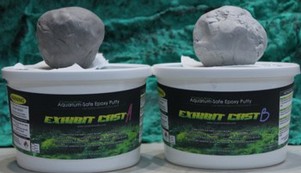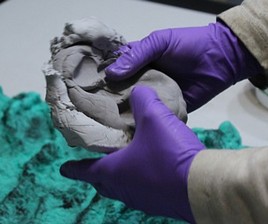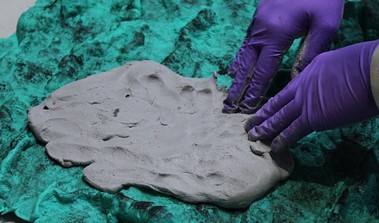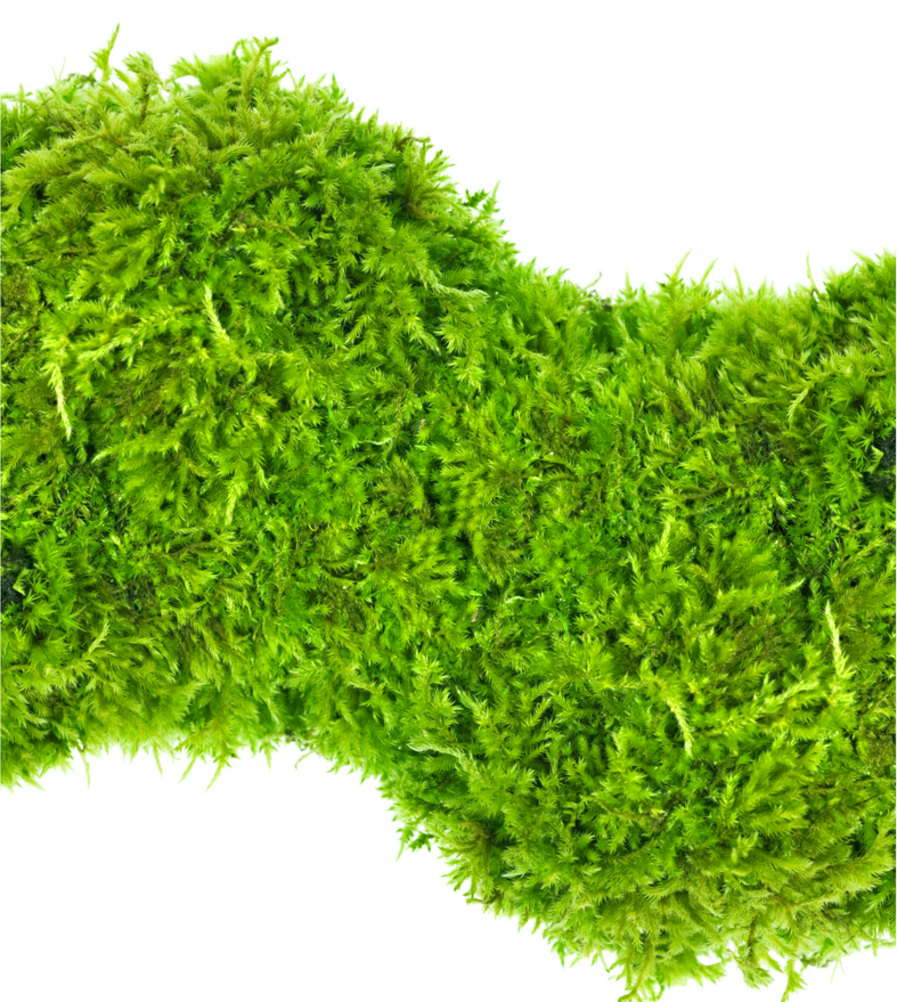



Always wear and use gloves while working with Exhibit Cast and all other epoxy materials! Avoid contact with the skin. Epoxies are capable of causing a skin sensitization reactions in people who have become sensitized to the amine hardener. Typically once sensitization is established in individuals, all subsequent exposures can lead to varying degrees of unpleasant allergic reactions. To avoid becoming sensitized to the Exhibit Cast's hardener, always wear gloves while working with the uncured material and all other uncured epoxy systems.
Instructions
1. While wearing gloves, take equal volumes of Exhibit Cast A and B out of their containers.
2. Mix and kneed by hand the Exhibit Cast A and B together until a uniform color is achieved.
Note: Once fully mixed you will have about 30 minutes to 2 hours of working time before it becomes too hard to use depending on temperature and volume. The more you putty you mix, and the warmer it is, the faster it will set. Work with fist sized volumes or less at a time to avoid too much heat generation. Caution: Putty gets hot!
Full cure is established in 24 hours. I recommend washing all Exhibit Cast objects before use.
1. While wearing gloves, take equal volumes of Exhibit Cast A and B out of their containers.
2. Mix and kneed by hand the Exhibit Cast A and B together until a uniform color is achieved.
Note: Once fully mixed you will have about 30 minutes to 2 hours of working time before it becomes too hard to use depending on temperature and volume. The more you putty you mix, and the warmer it is, the faster it will set. Work with fist sized volumes or less at a time to avoid too much heat generation. Caution: Putty gets hot!
Full cure is established in 24 hours. I recommend washing all Exhibit Cast objects before use.



Frequently Asked Questions
Is Exhibit Cast aquarium and dart frog safe?
Yes! When mixed and cured, Exhibit Cast is safe for use in aquariums, terrariums, and vivariums. It does not contain nonylphenol, unlike many other epoxy putties produced in the US, which is toxic to marine life and has been banned for most uses in UK due to it's extreme eco-toxicity.
The putty feels light, will casts float?
Yes. The putty is incredibly light weight while extremely strong. Since it is primarily meant for vivarium use it was designed to be light as possible. Since many have shown interest in using it in the aquarium as well, adding some weight in the form of small rocks or pebbles to your design may be necessary to weigh your casts down so they will sink. Otherwise you can simply silicone them down to the bottom of your tank or back glass.
Are there any tips or ticks you can recommend when working with Exhibit Cast?
1. When pressing into molds, you can mix the putty into balls then allow it to sit while you kneed up other batches. This will allow the putty to begin to set. This will decrease the amount of stickyness the putty has and can help when pressing the putty into the mold as it will be less apt to stick to your gloves and stay in the recesses of your mold, helping to achieve better detail.
2. If you want to make a unique color pattern on your background, you can mix various amounts of iron oxide pigment powder into mixed batches of Exhibit Cast. This will create subtle color differences between the batches. Then you can press these colors into the mold in different spots to help create a marbled effect or color striations or just add another level of uniqueness to your cast.
3. By mixing a few drops of water into a cup with a batch of mixed Exhibit Cast, you can lower it's viscosity and make it closer to a paste. This will allow you to brush or trowel on the epoxy much easier.
4. If making a paste, you can also add aquarium safe paint to help change the color of your epoxy.
There is still a slight tack to one side of my cured putty, is this normal?
Sometimes the epoxy hardener in the mixed Exhibit Cast will react with the atmospheric moisture and Co2. This can cause for what is commonly known in the epoxy trade as "blush". It's the reaction between the water in the air, the Co2 in the air, and the epoxy's amine hardener that creates this slight tack. Typically this is seen if a higher ratio of hardener side "A" was mixed into your epoxy batch, it takes a long time to cure due to being used in cold temperature, or the epoxy is cured in very humid conditions. You can tell it's just amine blush because only the faces in contact with the air will have any tack to it. If you are using the epoxy in a mold, the face down section in the mold won't have it due to being in contact with the mold face and not the air while curing. It's common and not a problem and can be washed way with water and a very dilute soap. Half a drop of Dial dishwashing soap with water washed onto the cast works well to remove it.
Is Exhibit Cast aquarium and dart frog safe?
Yes! When mixed and cured, Exhibit Cast is safe for use in aquariums, terrariums, and vivariums. It does not contain nonylphenol, unlike many other epoxy putties produced in the US, which is toxic to marine life and has been banned for most uses in UK due to it's extreme eco-toxicity.
The putty feels light, will casts float?
Yes. The putty is incredibly light weight while extremely strong. Since it is primarily meant for vivarium use it was designed to be light as possible. Since many have shown interest in using it in the aquarium as well, adding some weight in the form of small rocks or pebbles to your design may be necessary to weigh your casts down so they will sink. Otherwise you can simply silicone them down to the bottom of your tank or back glass.
Are there any tips or ticks you can recommend when working with Exhibit Cast?
1. When pressing into molds, you can mix the putty into balls then allow it to sit while you kneed up other batches. This will allow the putty to begin to set. This will decrease the amount of stickyness the putty has and can help when pressing the putty into the mold as it will be less apt to stick to your gloves and stay in the recesses of your mold, helping to achieve better detail.
2. If you want to make a unique color pattern on your background, you can mix various amounts of iron oxide pigment powder into mixed batches of Exhibit Cast. This will create subtle color differences between the batches. Then you can press these colors into the mold in different spots to help create a marbled effect or color striations or just add another level of uniqueness to your cast.
3. By mixing a few drops of water into a cup with a batch of mixed Exhibit Cast, you can lower it's viscosity and make it closer to a paste. This will allow you to brush or trowel on the epoxy much easier.
4. If making a paste, you can also add aquarium safe paint to help change the color of your epoxy.
There is still a slight tack to one side of my cured putty, is this normal?
Sometimes the epoxy hardener in the mixed Exhibit Cast will react with the atmospheric moisture and Co2. This can cause for what is commonly known in the epoxy trade as "blush". It's the reaction between the water in the air, the Co2 in the air, and the epoxy's amine hardener that creates this slight tack. Typically this is seen if a higher ratio of hardener side "A" was mixed into your epoxy batch, it takes a long time to cure due to being used in cold temperature, or the epoxy is cured in very humid conditions. You can tell it's just amine blush because only the faces in contact with the air will have any tack to it. If you are using the epoxy in a mold, the face down section in the mold won't have it due to being in contact with the mold face and not the air while curing. It's common and not a problem and can be washed way with water and a very dilute soap. Half a drop of Dial dishwashing soap with water washed onto the cast works well to remove it.

